“Failure I can live with. Not trying is what I can’t handle!” -Sanya Richards-Ross
It’s been another big week here at Starts With A Bang, with stories covering the Universe near and far. I myself was on vacation, but thanks to our generous Patreon supporters, I was able to put in the resources to get a week ahead and have a whole slew of stories to publish from afar. If you missed anything this week, go back and check it all out now (especially since I know some of you don't read the full stories) so that you don't miss out:
- How small can a piece of the Universe be and still expand? (for Ask Ethan),
- Cassini prepares for its final, suicidal mission (for Mostly Mute Monday),
- How did the Universe get its first supermassive black holes?,
- Science: where finding nothing is the biggest victory of all,
- The rarest light elements in the Universe, and
- Is everything in the Universe the same age?
With hundreds of comments to choose from, you've given me plenty to work with. Let's see what fantastic things I can make happen on this edition of our comments of the week!
From Michael Kelsey on measuring distances in the Universe: "From what you say, it sounds like directly comparing the luminosity distance (taking standard candles as correct) with the angular diameter distance, is enough to get the comoving distance directly. That’s very cool."
There is an a(t) time-dependence folded in, which is why all of these different distance measures depart from the naive Hubble estimate. But because luminosity, apparent size, comoving volume (affecting galaxy counts) and more evolve differently with this expansion, a few measurable qualities about the same object could give you true distances. The (1+z) factors that appear are strongly related to a(t), particularly when you remember that the definition of redshift is a(t_0)/a(t) = 1 + z. Physically, the luminosity measurement naively indicates a farther distance because time is dilated, and hence you see less starlight over the same time interval; there are equivalent explanations for all of these.
 The blackbody spectrum of the CMB, as measured by the FIRAS instrument aboard COBE. Image credit: NASA / COBE / FIRAS / UCLA.
The blackbody spectrum of the CMB, as measured by the FIRAS instrument aboard COBE. Image credit: NASA / COBE / FIRAS / UCLA.
From Narad on statistics and significance: "Ahem. It’s not at all clear to me how one gets to reverse-engineer reported 1 σ uncertainties into “significance.”"
This depends completely on the distribution of your data points and what pattern they follow. If these are Gaussian/normally distributed data and uncertainties, you can safely just scale up significances: 1σ is 68%, 2σ is 95%, 3σ is 99.7%, 4σ is 99.99%, etc. This does not account for systematic errors in any way, but for statistical significance, this is the way to go. For other distributions (e.g., Poisson), there are other prescriptions that are equally valid.
The GOODS-N field, with galaxy GN-z11 highlighted: the presently most-distant galaxy ever discovered. Image credit: NASA, ESA, P. Oesch (Yale University), G. Brammer (STScI), P. van Dokkum (Yale University), and G. Illingworth (University of California, Santa Cruz).
From Paul Dekous on an alternative to cosmic expansion: "Alright, so here’s the obvious opposite question by a contrarian, could it be that everything is shrinking, like for ‘normal’ matter that is cooling down, evaporating energy?"
If this were the case, we could look for time variation in certain things we believe to be physically constant, like nuclear or atomic absorption/emission lines. There was a review paper by Georg Raffelt about a decade ago where he went over these possibilities, and they are constrained out to many decimal places, even at high redshift. Since things like the size of an atom are determined by certain fundamental constants (charge of an electron, planck's constant, speed of light, etc.) you have to vary at least one to change this. The constraints on any of them changing (in any combination you can contrive) is that they are less than 7% off from their present values from the time of the CMB's emission (380,000 years) to the present day (13.8 billion years). On the other hand, the Universe has expanded by a factor of ~1100 since then.
So no, everything cannot be shrinking.
 If everything expanded as the Universe did, then the coins would need to be replaced by paint. Image credit: "Fun with Astronomy" by Mae and Ira Freeman, via http://amzn.to/2aKd9qD.
If everything expanded as the Universe did, then the coins would need to be replaced by paint. Image credit: "Fun with Astronomy" by Mae and Ira Freeman, via http://amzn.to/2aKd9qD.
From anonymous coward on the Universe's fate: "Of course, this all depends on the nature of Dark Energy. If it really is just a cosmological constant or quintessence in a certain form, then the universe will never expand quickly enough to dominate the other fundamental interactions that work to keep stuff together. But if the universe has a phantom energy quintessence though, space will eventually expand so rapidly that all structures bound by the other interactions will become unbound by it, producing a Big Rip."
This is true, and my analysis was based on the assumption that dark energy really is just a cosmological constant. But this is more than just some bias I chose, this is a conclusion based on the data we see. Theoretically, what determines how a form of energy evolves over time in the Universe is the relationship between its density and its cosmological pressure. For normal matter, the pressure is effectively zero; for radiation, it's +1/3 times the density. This explains why the total energy density of matter evolves as the inverse of the cube of the scale of the Universe, but radiation as the inverse fourth power. In general, reasonable things one can write down go in increments of ±1/3.
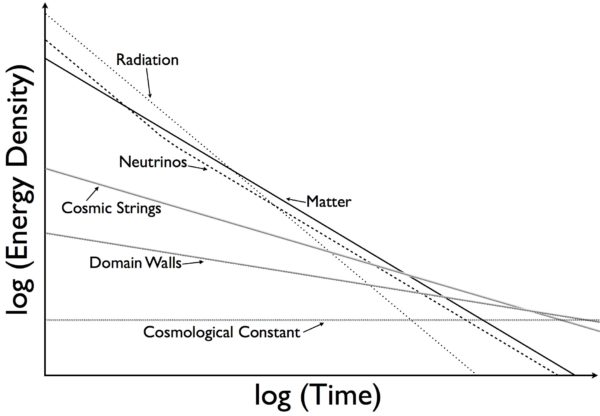 Evolution of different components of the Universe over time. Image credit: E. Siegel, from Beyond The Galaxy.
Evolution of different components of the Universe over time. Image credit: E. Siegel, from Beyond The Galaxy.
What we know as dark energy has the pressure equal to -3/3 the density (cosmic strings and domain walls are -1/3 and -2/3, respectively, and are not observed in our Universe), and the constraints are very good. A decade ago, it was observed to be -1.0 ± 0.3; now it's -1.0± 0.08 thanks to the latest BAO surveys. I myself have cooked up dissatisfying models were that parameter -- known as w -- is something like -8/9 or -11/12, but it's looking more and more like it truly is a cosmological constant. To get a big rip, dark energy needs to strengthen (and become more negative) over time. It's possible, but there's no good motivation for it as well as no good evidence for it.
I'll encourage everyone to keep it in mind as a possibility, but not to buy any stock in it.
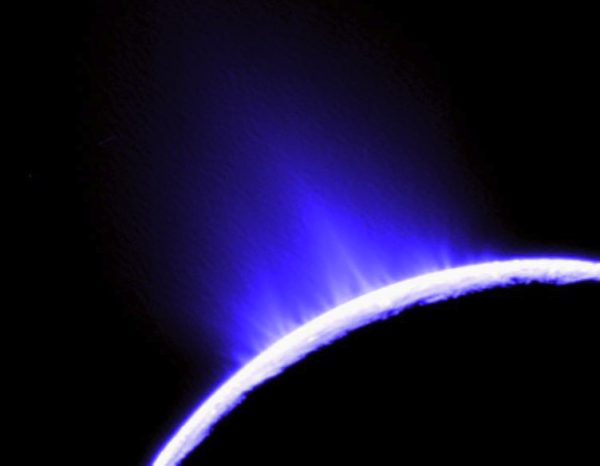 This is a false-color image of jets (blue areas) in the southern hemisphere of Enceladus taken with the Cassini spacecraft narrow-angle camera on Nov. 27, 2005. Image credit: NASA/JPL/Space Science Institute.
This is a false-color image of jets (blue areas) in the southern hemisphere of Enceladus taken with the Cassini spacecraft narrow-angle camera on Nov. 27, 2005. Image credit: NASA/JPL/Space Science Institute.
From Jim Paige on Cassini's upcoming demise: "The story didn’t talk about the “contamination” that the lead-in link highlights. I guess we’re supposed to know that NASA thinks Cassini would harm life on one of these moons?"
There's nothing particularly egregious about Cassini, except to say that it came from Earth. There are different standards a spacecraft has to meet if it wants to land on another world versus orbit another world. The risk of contamination -- where Earth-life lands on and infests another world -- is very high for anything launched from Earth, and so we try and be careful to not seed a possibly inhabited world with Earth-based life before investigating its own life first. We may have botched this on Mars with the Viking landers already!
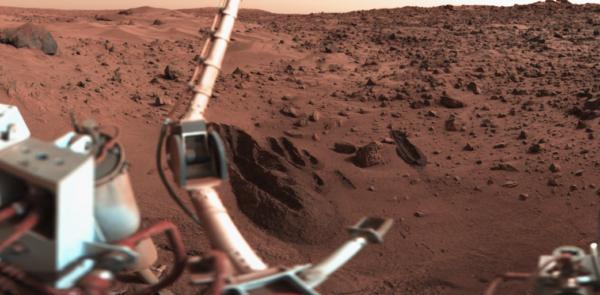 The Viking 1 Lander sampling arm and the deep trenches it dug as part of the surface composition and biology experiments on Mars. Images credit: NASA and Roel van der Hoorn.
The Viking 1 Lander sampling arm and the deep trenches it dug as part of the surface composition and biology experiments on Mars. Images credit: NASA and Roel van der Hoorn.
Cassini was designed to orbit Saturn and photograph the ringed world, its rings, moons, and other phenomena. But it was never designed -- except for the Huygens probe -- to land on another world. Crashing Cassini into Saturn avoids the potential contamination of any of its moons with Earth-originating life. At least, that's the idea.
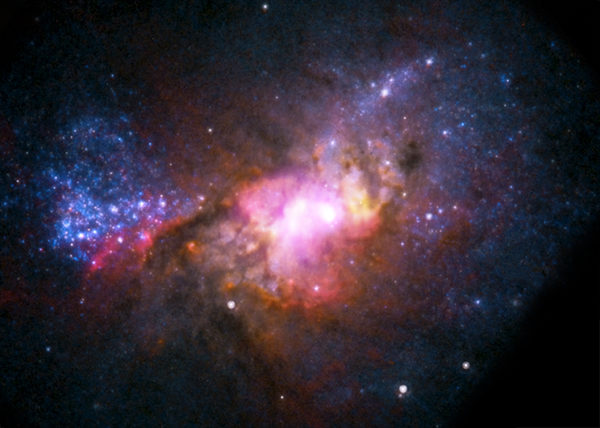 The starburst galaxy Henize 2-10, located 30 million light years away. Image credit: X-ray (NASA/CXC/Virginia/A.Reines et al); Radio (NRAO/AUI/NSF); Optical (NASA/STScI).
The starburst galaxy Henize 2-10, located 30 million light years away. Image credit: X-ray (NASA/CXC/Virginia/A.Reines et al); Radio (NRAO/AUI/NSF); Optical (NASA/STScI).
From Denier on Supermassive Black Hole formation: "How do we know ultra-massive black holes don’t predate stars? I had thought the theory behind direct collapse black holes is they formed at a time when the universe was so hot the cloud fragmentation necessary for star formation wasn’t possible."
Okay, I'm going to try and squeeze a lot of astrophysics here into a very small space. The idea that supermassive black holes formed well before any stars formed is a special case of the primordial black hole scenario, not a direct collapse black hole. Basically, to get runaway (nonlinear) gravitational collapse, you need to have a region of space that's approximately 68% denser than average. Under standard structure formation conditions -- given the fluctuations generated from inflation, observed in the CMB, causing the large-scale structure we see -- the very first stars form between 50-100 million years after the Big Bang. In certain finely-tuned cases, supermassive primordial black holes form before that, but only if you have a particularly large initial fluctuation on the scales that SMBHs form and no other.
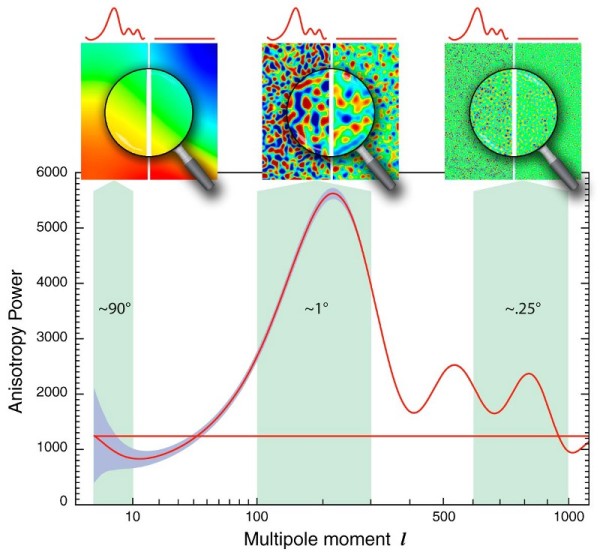 Fluctuations would need to be many orders of mangitude larger on a very small, specific scale to create primordial SMBHs. Image credit: NASA / WMAP science team.
Fluctuations would need to be many orders of mangitude larger on a very small, specific scale to create primordial SMBHs. Image credit: NASA / WMAP science team.
Moving on from that. There are three non-terrible scenarios for producing SMBHs:
- Forming a bunch of stars that make low-mass black holes and merge,
- Forming a bunch of stars that merge and make SMBH seeds when they die,
- Direct collapse of massive regions of gas into the seeds of SMBHs, without forming stars as an interim step.
All three scenarios involve star formation as a necessary co-existing step. There are a number of things that must be accurately modeled to account for the amount of fragmentation you get, including radiative cooling, changes in opacity due to dust, dust heating and cooling, atomic and molecular heating and cooling, and cosmic ray heating, among others. If you can get low enough amounts of fragmentation in the densest regions, that will give you a direct collapse black hole.
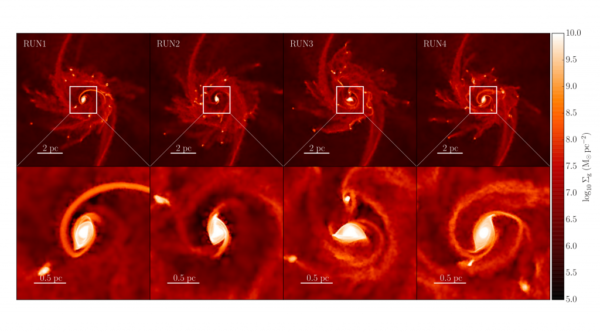 Four different simulations of galaxy-galaxy mergers with low fragmentations. Image credit: Fig. 3 of Mayer et al. (2014), via http://arxiv.org/abs/1411.5683.
Four different simulations of galaxy-galaxy mergers with low fragmentations. Image credit: Fig. 3 of Mayer et al. (2014), via http://arxiv.org/abs/1411.5683.
Even in this case, the first stars form before the first SMBHs. Even in Mitch Begelman's "quasistar" explanation, which does not fall into the non-terrible scenario regime, other stars exist contemporaneously with his quasistars. Cloud fragmentation, to go back to your original understanding, is seen as inevitable, including from simple primordial hydrogen and helium. To suppress it is thought to require the sorts of things that only pre-existing structures would give rise to. This likely means that direct collapse black holes are not the first black holes in the Universe, but they may be the first ones to be large enough to serve as SMBH seeds.
(That wasn't as concise as I wanted, but that's not bad!)
A Schematic design of the IceCube experiment. Image credit: IceCube Science Team - Francis Halzen, Department of Physics, University of Wisconsin.
From Denier (again! Two great questions/comments this week) on sterile neutrinos and IceCube: "From the very beginning this experiment seemed to me like a poorly conceived, colossal waste of money doomed to discover nothing about anything. My problem with it, and I may be wrong here, I under the impression neutrinos didn’t have a physical diameter. The researchers were looking for collision events for a ‘sterile’ particle that was inert electromagnetically, didn’t react via the weak or strong nuclear force, and didn’t have a physical body. What was it exactly they expected to collide with anything?"
There were some attempted answers further down the thread, but none of them really hit on what I would've said, so here you go. Neutrinos arise from all sorts of phenomena: the Sun, cosmic rays, radioactive decays, and scattering of other particles off of the atmosphere. IceCube has been a tremendous success in a number of fields:
- It's detected the largest number of high-energy cosmic rays ever,
- It's detected the first neutrinos since 1987 to originate outside our galaxy,
- It's detected the neutrino-shielding effects of the Moon, and
- It's detected neutrinos that have traveled through the Earth, enabling us to take pictures of the Sun at night.
 And it wasn't the first neutrino-based photo of the Sun at night, either. Image credit: © R. Svoboda, K. Gordan, from Kamioka observatory.
And it wasn't the first neutrino-based photo of the Sun at night, either. Image credit: © R. Svoboda, K. Gordan, from Kamioka observatory.
It also measured a number of important parameters to the best accuracy ever about atmospheric neutrinos. If sterile neutrinos were real, the energy spectrum of atmospheric neutrinos would have been distorted at energies right around ~1 TeV. IceCube was the only detector capable of making this measurement, and its preliminary results indicated that there was a surprising distortion there, although it was nowhere near the 5-sigma threshold needed for discovery. The latest results indicate that the earlier results were a fluke, and that sterile neutrinos have no evidence for them. That's the story!
A model of the accelerator used to bombard Lithium and create the Be-8 used in the key experiment, located at the entrance of the Institute of Nuclear Research of the Hungarian Academy of Sciences. Image credit: Yoav Dothan.
From axil on telling me what to do: "Please write a post on how grand unification is affected by the recent protophobic gauge boson discovery and theoretical conformation."
Okay. Look for it this week, but it isn't going to say what you want or expect.
 Understanding the cosmic origin of all the elements heavier than hydrogen can give us a powerful window into the Universe’s past, as well as insight into our own origins. Image credit: Wikimedia Commons user Cepheus.
Understanding the cosmic origin of all the elements heavier than hydrogen can give us a powerful window into the Universe’s past, as well as insight into our own origins. Image credit: Wikimedia Commons user Cepheus.
From Malakyp on Li, Be and B: "Your article says that spallation is the “only reason” why Li, Be, and B exist at all, but that’s not strictly accurate. Big Bang nucleosynthesis produced some quantities of 7Li and 7Be"
And Be-7 all decayed away before the first star ever formed, and the Li-7 produced from BBN was not only destroyed by stars in great percentages, but is out-created by about an order of magnitude by spallation when it comes to the lithium in the Universe. So spallation is the only reason that any Be, B, and ~90% of the Li that's present on Earth exist at all, if you want to be strictly accurate.
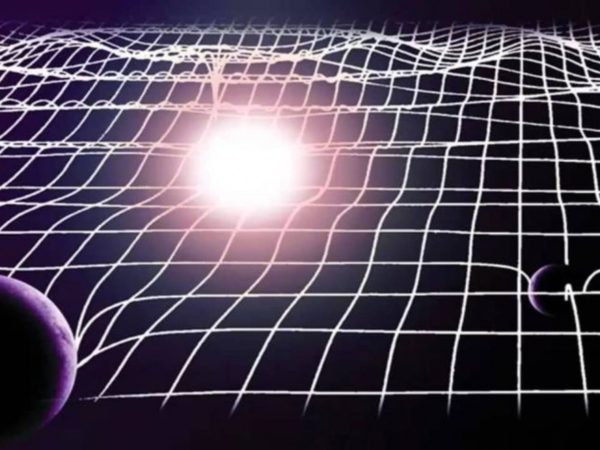 The fabric of spacetime, illustrated, with ripples and deformations due to mass. Image credit: European Gravitational Observatory, Lionel BRET/EUROLIOS.
The fabric of spacetime, illustrated, with ripples and deformations due to mass. Image credit: European Gravitational Observatory, Lionel BRET/EUROLIOS.
From philip coleman on... well, I'm not sure: "Space time continuum is subject too the constant law of absolute nothing paradox which is a impossibility. Think in reality as eternal and your human mind is blown away with impossible."
What's kind of funny is that if you wanted to tell the cosmic story of the origin and creation of our Universe as we know and perceive it, then you'd begin with, "In the beginning, there was nothing." Only it wouldn't be the kind of nothing you think of as nothingness. There would still be space, time, and laws governing it. It would even have different properties from the Universe we see today in terms of vacuum energy density. And yet, without space and time there isn't any way to talk sense about the Universe; what's "outside" of space or "before" time? Fun stuff... and maybe, when it's time to write my third book (the second is underway, and I can talk about it SOON), that will be the subject?
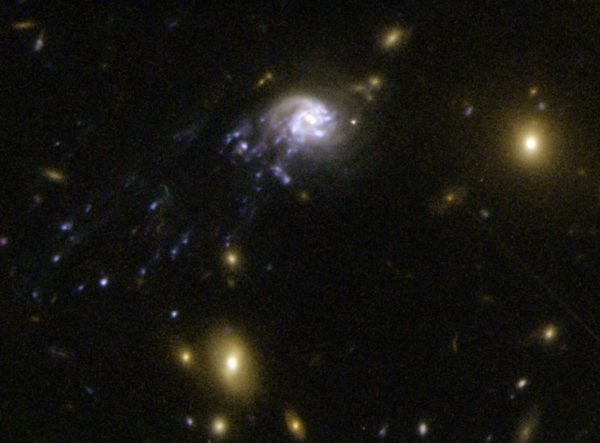 One of the fastest known galaxies in the Universe, speeding through its cluster (and being stripped of its gas) at a few percent the speed of light: thousands of km/s. Image credit: NASA, ESA, Jean-Paul Kneib (Laboratoire d’Astrophysique de Marseille) et al.
One of the fastest known galaxies in the Universe, speeding through its cluster (and being stripped of its gas) at a few percent the speed of light: thousands of km/s. Image credit: NASA, ESA, Jean-Paul Kneib (Laboratoire d’Astrophysique de Marseille) et al.
And finally, some words of wisdom from PJ: "We each have our own path to take and learn the lessons on the way. While most of us forge ahead, many are not aware of their next step, don’t see it, are too scared to move forward, or just content to never advance. At some stage of our lives, we have been shown the tools and how to use them. It is still up to the individual to do what they will with them. No need to pity; just be thankful they will eventually learn."
Earlier this month, I turned 38 years old. And I got a little fed up with someone my same age acting in a way that was completely acceptable for a grown, adult person to act towards another. And I knew what their motivation was, and what their history was, and what their personal/childhood issues were that led to this behavior, and I couldn't keep my mouth shut anyway. At some point, it doesn't matter what your history is or how you came to be the mess that you are at the present moment; you have to behave as a decent person to other people. You can't go around randomly treating other people like garbage because of your own un-dealt-with issues. It's part of being a decent adult. And it's something I hope we can all live up to all (or almost all) of the time.
And with that, I can't wait to spend the next week with you, either. New podcast coming in a week, too!

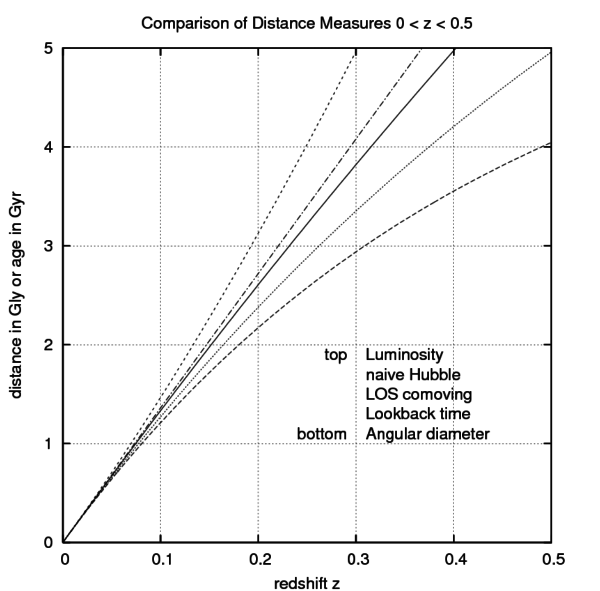
“What’s kind of funny is that if you wanted to tell the cosmic story of the origin and creation of our Universe as we know and perceive it, then you’d begin with, “In the beginning, there was nothing.” Only it wouldn’t be the kind of nothing you think of as nothingness. THERE WOULD STILL BE SPACE, TIME, AND LAWS GOVERNING IT.”
1)What was the size of space before the big bang?
2)I see “time” as a measure of change; without change, time does not exist. If time existed before the big bang, what exactly was changing?
3)On what scientific basis can you say the laws which govern the universe predated things the laws govern?
“What’s kind of funny is that if you wanted to tell the cosmic story of the origin and creation of our Universe as we know and perceive it, then you’d begin with, “In the beginning, there was nothing.” Only it wouldn’t be the kind of nothing you think of as nothingness. THERE WOULD STILL BE SPACE, TIME, AND LAWS GOVERNING IT.”
1) What was the size of space before the big bang?
2) I see “time” as a measure of change; without change, time does not exist. If time existed before the big bang, what exactly was changing?
3) On what scientific basis can you say the laws which govern the universe predated the things the laws govern?
Thanks Ethan … and happy birthday! :)
I know this. Recall the original context:
Happies again, Ethan. For next year, your present, should you accept it, is a total solar eclipse on Aug 21, 2017. You will not have to drive far to be on the centreline. Just a shame it will not be long lived - ~ 2 mins.
That's nice, but enthusiasm about random thought-blobs represents neither a rational basis for demanding that other people explore them nor a coherent "challenge" to someone talking about something specific.